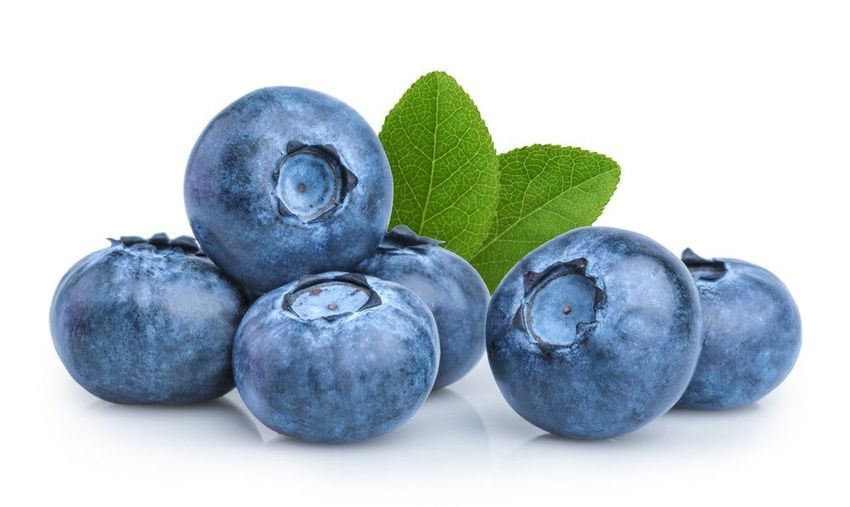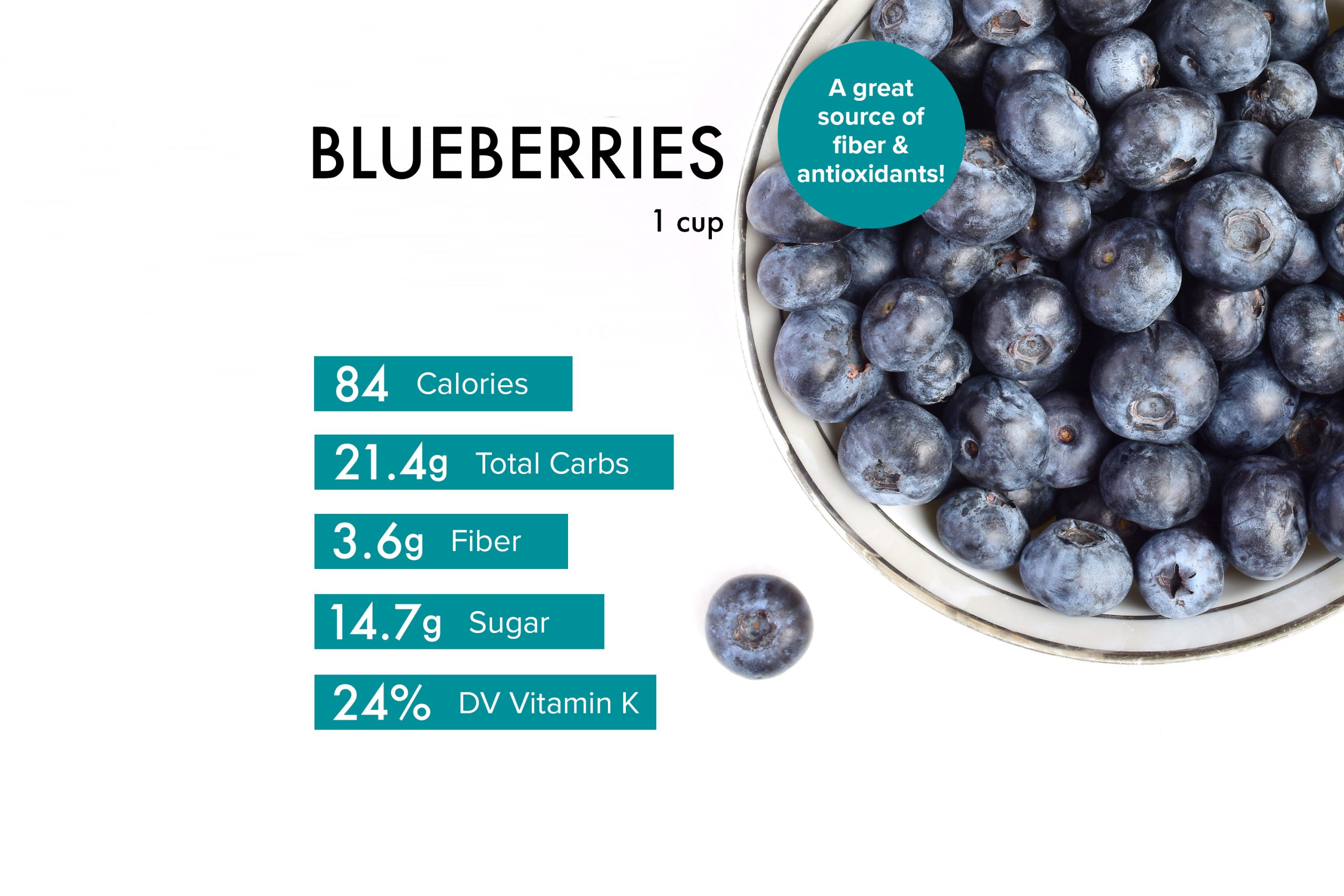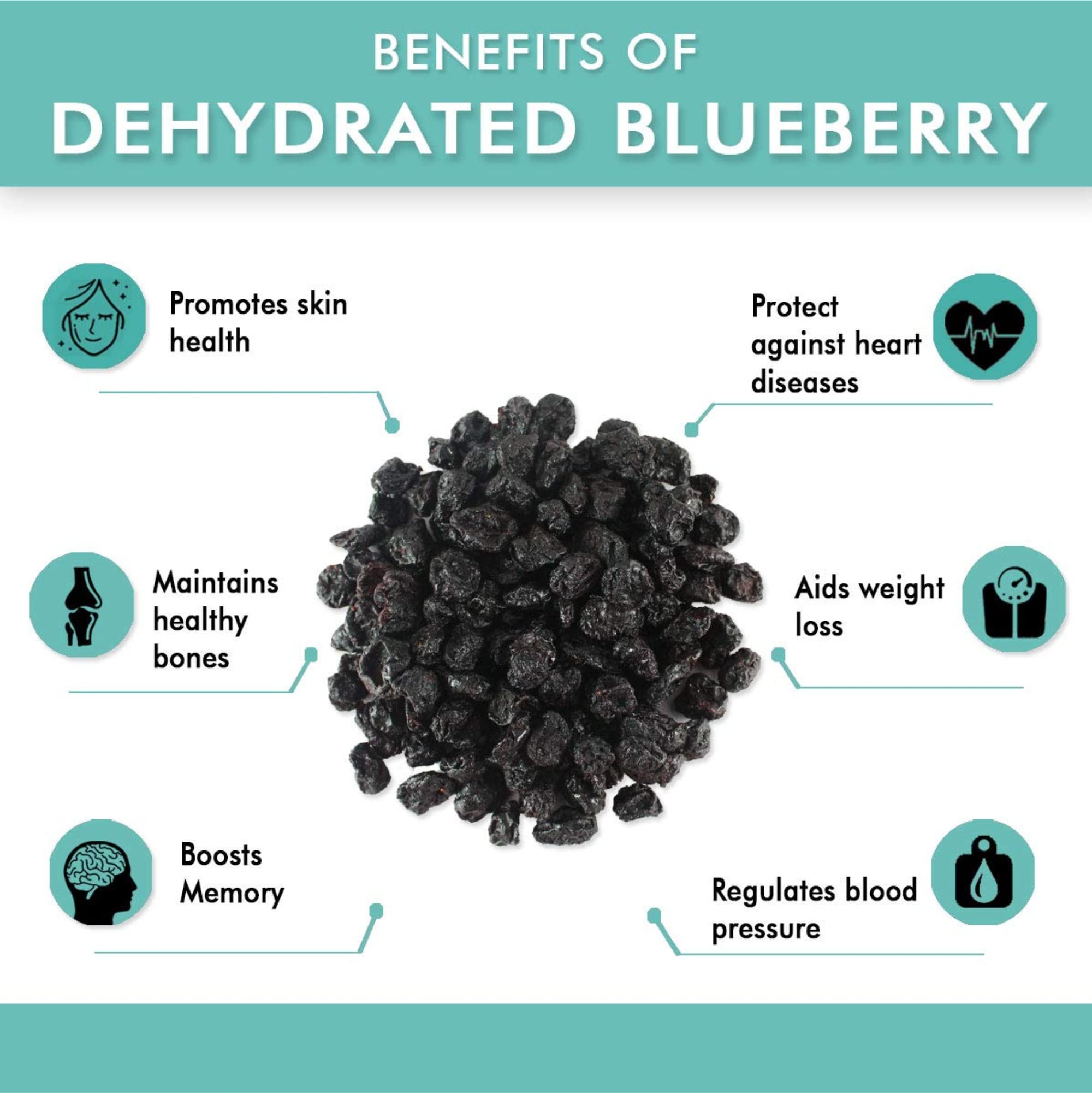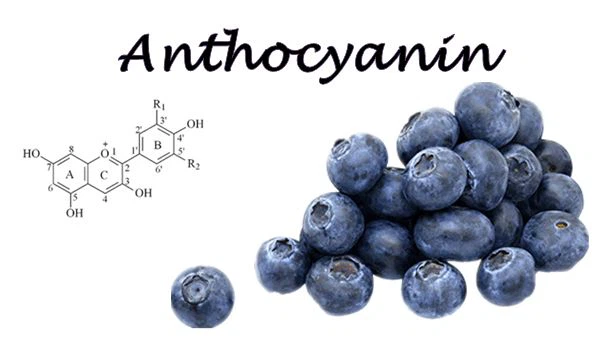Introduction to Blueberries

Source: fourwindsgrowers.com
Blueberries 101
Tiny but mighty, blueberries stand as one of nature’s most impressive nutritional powerhouses. The blueberry bush (Vaccinium sect. Cyanococcus) produces these small, round berries that have captured the attention of health enthusiasts worldwide. [#1]
What makes these little blue gems so special? Their deep blue-purple hue isn’t just pretty—it signals the presence of powerful compounds that can transform your health. Blueberries have earned their reputation as a superfruit due to their exceptional nutrient density and health-promoting properties. [#2]
Native to North America, these berries pack an impressive nutritional punch despite their small size. A single cup contains:
- Only 84 calories
- 4 grams of fiber
- 24% of your daily Vitamin C needs
- 36% of your daily Vitamin K needs
- 25% of your daily manganese needs
But what truly sets blueberries apart from other fruits is their extraordinary concentration of antioxidants. While other superfoods like broccoli offer impressive nutritional benefits, blueberries contain some of the highest antioxidant levels of any commonly consumed fruit or vegetable.
History and Background
The story of blueberries stretches back thousands of years. Native Americans valued these berries not just as food but as medicine. They used blueberries and their leaves to treat coughs, and created a tea from the leaves believed to purify blood. They also developed one of the first blueberry preservation methods—drying the berries in the sun and pounding them into powder to preserve meat.
Wild blueberries have been growing in North America for over 13,000 years, but commercial cultivation is relatively recent. In 1911, Elizabeth White collaborated with botanist Frederick Coville to develop the first commercial blueberry varieties. Their work transformed these wild berries into the plumper, juicier fruits we recognize today.
Blueberries grow in clusters on bushes that can range from just a few inches tall (lowbush varieties) to over 6 feet (highbush varieties). The berries start green, then turn reddish-purple, and finally deep blue-purple when fully ripe. This color transformation signals the development of anthocyanins—the powerful antioxidant compounds that give blueberries their health-promoting properties.
Today, blueberries are cultivated across North America, South America, Europe, Australia, and New Zealand. The United States and Canada remain the world’s largest producers, with Maine and Michigan leading U.S. production. Wild blueberries, smaller but often more intensely flavored than cultivated varieties, continue to grow throughout northern forests and are prized for their concentrated nutritional value.
Nutritional Profile of Blueberries

Source: livestrong.com
Nutrient Composition
Blueberries may be small, but their nutritional profile is remarkably impressive. These vibrant berries deliver an exceptional array of vitamins, minerals, and beneficial plant compounds while remaining low in calories. This combination makes them an ideal addition to virtually any dietary pattern.
A single cup (150 grams) of fresh blueberries provides a substantial nutritional boost, containing 13% of the Daily Value (DV) for fiber, 14% of the DV for vitamin C, and 24% of the DV for vitamin K. This nutrient density is particularly noteworthy considering their modest caloric content.
Beyond these key nutrients, blueberries also contain significant amounts of manganese, which supports metabolism and bone development. The presence of iron further enhances their nutritional value, contributing to oxygen transport throughout the body. [#3]
Blueberries vs. Other Berries
While all berries offer health benefits, blueberries stand out in several ways. Compared to strawberries, raspberries, and blackberries, blueberries typically contain higher levels of anthocyanins—the compounds responsible for their distinctive blue-purple color and many of their health benefits.
The antioxidant capacity of blueberries also tends to exceed that of many other berry varieties. This is measured using the Oxygen Radical Absorbance Capacity (ORAC) scale, where blueberries consistently score among the highest of commonly consumed fruits.
What sets blueberries apart from their berry cousins is their specific anthocyanin profile. While raspberries and blackberries contain different types of these compounds, the particular anthocyanins in blueberries appear to have especially potent effects on brain health and cognitive function.
- Blueberries: Highest in anthocyanins, excellent for brain health
- Strawberries: Higher in vitamin C, lower in anthocyanins
- Raspberries: Higher in fiber, different anthocyanin profile
- Blackberries: Similar antioxidant content, different phytonutrient composition
Caloric and Macronutrient Content
For those monitoring their caloric intake, blueberries offer tremendous nutritional value with minimal caloric impact. An entire cup of blueberries contains only 84 calories and 21.5 grams of carbohydrates. This makes them an excellent choice for those seeking nutrient-dense foods that won’t significantly impact daily calorie goals.
The macronutrient breakdown of blueberries reveals their balanced nutritional profile:
- Carbohydrates: 21.5g per cup (primarily natural sugars and fiber)
- Protein: 1.1g per cup
- Fat: 0.5g per cup (primarily healthy unsaturated fats)
- Fiber: 3.6g per cup [#4]
The fiber content of blueberries deserves special attention. With approximately 3.6 grams per cup, blueberries provide both soluble and insoluble fiber. Soluble fiber helps regulate blood sugar levels and reduces cholesterol, while insoluble fiber promotes digestive health and regularity. This fiber content also contributes to the berries’ relatively low glycemic index, meaning they have a modest impact on blood sugar levels despite their natural sweetness.
The natural sugars in blueberries—primarily fructose and glucose—provide quick energy without the blood sugar spikes associated with refined sugars. When combined with their fiber content, these natural sugars are released more slowly into the bloodstream, making blueberries a smart choice even for those monitoring their blood glucose levels.
Compared to many other sweet snacks, blueberries offer a remarkable nutritional bargain—delivering essential vitamins, minerals, antioxidants, and fiber for relatively few calories. This exceptional nutrient density explains why health professionals frequently recommend incorporating these brilliant blue fruits into daily eating patterns.
Health Benefits of Blueberries

Source: amazon.com
Antioxidant Properties
Blueberries are renowned for their exceptional antioxidant content, which places them among the most powerful disease-fighting foods available. These tiny fruits contain impressive levels of anthocyanins, the compounds responsible for their deep blue-purple hue. These antioxidants work tirelessly within the body to neutralize harmful free radicals that would otherwise damage cells and accelerate aging.
The antioxidant capacity of blueberries extends beyond just anthocyanins. They also contain other protective compounds like quercetin, myricetin, and resveratrol. Together, these substances create a formidable defense system against oxidative stress. Antioxidants in blueberries help prevent cell damage and protect against chronic diseases like cancer, heart disease, and diabetes. [#5]
Research consistently demonstrates that regular consumption of blueberries can significantly boost antioxidant levels in the blood, providing lasting protection against cellular damage throughout the day.
Cardiovascular Health
The heart-protective benefits of blueberries have been extensively documented in scientific literature. Regular consumption appears to address multiple risk factors for cardiovascular disease simultaneously.
Blueberries may help reduce risk factors for heart disease, such as blood pressure and arterial stiffness. In one notable study, participants who consumed blueberry powder daily for eight weeks experienced an average 5% decrease in blood pressure—a reduction comparable to some prescription medications.
Beyond blood pressure management, blueberries contribute to heart health through several mechanisms:
- Reducing arterial stiffness, allowing blood vessels to remain flexible
- Decreasing LDL cholesterol oxidation, a key factor in atherosclerosis development
- Improving endothelial function, enhancing blood vessel performance
- Reducing inflammation markers associated with heart disease
These cardiovascular benefits appear most pronounced when blueberries are consumed regularly as part of a balanced diet, rather than occasionally or in isolation.
Brain Health and Cognition
Perhaps the most fascinating aspect of blueberry research involves their effects on brain function. The same anthocyanins that protect the heart also cross the blood-brain barrier, where they accumulate in regions associated with learning and memory.
Multiple studies have demonstrated that blueberry consumption can slow age-related cognitive decline and potentially improve memory. In older adults with mild cognitive impairment, daily blueberry consumption has been shown to improve memory performance and neural activation.
The neuroprotective effects of blueberries appear to work through several pathways:
- Reducing neuroinflammation that contributes to brain aging
- Improving communication between neurons
- Enhancing brain plasticity and formation of new neural connections
- Increasing blood flow to critical brain regions
These cognitive benefits mirror those seen with other brain-supporting foods like walnuts, though blueberries offer a distinct anthocyanin profile that provides complementary effects.
Diabetes and Blood Sugar Control
Despite containing natural sugars, blueberries have a surprisingly beneficial effect on blood sugar regulation. Their low glycemic index combined with high fiber content helps prevent rapid blood glucose spikes after consumption.
Improved insulin sensitivity may lower the risk of metabolic syndrome and type 2 diabetes. Research indicates that the anthocyanins in blueberries can enhance insulin sensitivity by up to 22% in insulin-resistant individuals.
For those already managing diabetes, incorporating blueberries into meals may help moderate post-meal blood sugar levels. The fiber in blueberries slows carbohydrate digestion, while their bioactive compounds appear to support pancreatic function and improve cellular glucose uptake.
Anti-Inflammatory Effects
Chronic inflammation underlies many modern diseases, from arthritis to heart disease. Blueberries contain multiple anti-inflammatory compounds that help dampen excessive inflammatory responses throughout the body.
Laboratory studies have shown that blueberry compounds can inhibit inflammatory enzymes and reduce the production of pro-inflammatory cytokines. This systemic anti-inflammatory action may explain why blueberry consumption is associated with reduced risk across so many different disease categories.
The anti-inflammatory benefits of blueberries appear particularly valuable for joint health, with some research suggesting regular consumption may help alleviate symptoms of arthritis and other inflammatory joint conditions.
Cancer Prevention
While no single food can prevent cancer, substantial evidence suggests that blueberries may reduce cancer risk through multiple mechanisms. Their high antioxidant content helps prevent the DNA damage that can initiate cancer development.
Beyond antioxidant protection, blueberry compounds have demonstrated additional anti-cancer properties in laboratory studies:
- Inhibiting the proliferation of cancer cells
- Promoting apoptosis (programmed cell death) in abnormal cells
- Reducing inflammation that can promote cancer growth
- Limiting angiogenesis (formation of new blood vessels that feed tumors)
Research has shown particular promise for blueberries in reducing risk of colorectal, breast, and prostate cancers, though more human studies are needed to fully understand these protective effects.
Digestive Health
The fiber content in blueberries—both soluble and insoluble—provides significant benefits for digestive health. This fiber serves as food for beneficial gut bacteria, promoting a healthy microbiome balance.
Recent research suggests that the anthocyanins in blueberries may also directly influence gut bacteria composition, favoring beneficial strains that produce anti-inflammatory compounds. This prebiotic effect may contribute to improved digestive function and reduced risk of intestinal disorders.
Additionally, the fiber in blueberries supports regular bowel movements and helps prevent constipation, a common digestive complaint. The natural plant compounds in blueberries may also help protect the digestive tract lining from damage and inflammation.
Bone and Skin Health
Blueberries are a good source of vitamin K and manganese, important for bone health. Vitamin K plays a crucial role in bone formation and helps the body properly utilize calcium, while manganese contributes to bone development and maintenance.
Regular consumption of these nutrients through foods like blueberries may help maintain bone density and reduce fracture risk, particularly when combined with adequate calcium intake and weight-bearing exercise.
The skin benefits from blueberry consumption as well. The antioxidants in blueberries help protect skin cells from damage caused by sun exposure and environmental pollutants. Some research suggests that the collagen-protecting effects of blueberry compounds may help maintain skin elasticity and reduce the appearance of aging.
Vision and Eye Health
The connection between blueberries and eye health extends beyond old wives’ tales. These berries contain specific compounds that accumulate in the retina, where they can protect delicate eye tissues from light damage and oxidative stress.
Anthocyanins in blueberries have been shown to improve night vision and reduce eye fatigue. They may also help prevent age-related macular degeneration and cataracts, two common causes of vision loss in older adults.
The protective effects on eye health appear most significant when blueberries are consumed regularly over time, allowing their beneficial compounds to accumulate in ocular tissues. This long-term protection highlights the importance of incorporating these berries into regular dietary patterns rather than as occasional treats.
Like pomegranates, blueberries offer a concentrated source of antioxidants that support multiple body systems simultaneously. Their wide-ranging benefits make them a truly exceptional addition to any health-conscious eating plan.
Scientific Research on Blueberries

Source: qyherb.com
Anthocyanins and Bioavailability
The remarkable health benefits of blueberries can be largely attributed to their rich anthocyanin content. These powerful compounds give blueberries their characteristic blue-purple color and serve as the focal point of extensive scientific investigation. Researchers have identified more than two dozen different anthocyanins in blueberries, each with potentially distinct biological activities.
Understanding how these compounds work in the body requires examining their bioavailability—how well they’re absorbed and utilized after consumption. Studies show that anthocyanins are absorbed relatively quickly, with peak blood concentrations occurring within 1-2 hours after eating blueberries. However, their absolute bioavailability is relatively low, with only about 12% of consumed anthocyanins appearing in circulation.
This apparent paradox—low bioavailability yet strong health effects—has led scientists to several important discoveries:
- Anthocyanins undergo extensive metabolism in the gut and liver
- Their metabolites may be responsible for many observed health benefits
- The gut microbiome plays a crucial role in converting anthocyanins into active compounds
- These compounds may accumulate in tissues over time with regular consumption
Recent advances in analytical techniques have allowed researchers to track these metabolites more effectively, revealing that the biological impact of blueberries extends far beyond what earlier studies could detect.
Clinical and Population Studies
Laboratory findings on blueberries have been reinforced by compelling human research. A 2024 review found that consuming blueberries daily for just one month could significantly improve blood flow and blood vessel dilation, highlighting their rapid cardiovascular benefits.
The brain-boosting potential of these berries has been demonstrated in multiple clinical trials. A 2023 study discovered that daily blueberry powder consumption could help maintain brain function and improve memory in older adults, suggesting these fruits might play a role in cognitive preservation during aging.
Large population studies have yielded equally impressive findings. Research indicates that higher intakes of blueberries, strawberries, and total anthocyanins are associated with a 32% lower rate of myocardial infarction, representing a substantial reduction in heart attack risk. [#6]
For metabolic health, the evidence is similarly strong. In a placebo-controlled study involving obese, insulin-resistant adults, insulin sensitivity was significantly greater after just 6 weeks of regular blueberry intake, demonstrating these berries’ potential in addressing metabolic dysfunction.
Athletic performance may also benefit from blueberry consumption. A 2018 study found that blueberries could improve exercise performance while decreasing certain inflammatory markers, suggesting potential applications for both competitive athletes and everyday fitness enthusiasts.
What makes these clinical findings particularly valuable is their consistency across different populations and health conditions. From children to older adults, from healthy individuals to those with chronic conditions, the beneficial effects of blueberries appear remarkably consistent, though the magnitude of benefit may vary based on individual factors.
The dose-response relationship observed in many studies suggests that even modest blueberry consumption (equivalent to about ½ cup daily) can provide measurable health benefits, while higher intakes may offer additional advantages up to a certain threshold. This makes blueberries a practical addition to most dietary patterns, requiring relatively small adjustments to achieve meaningful health improvements.
As research techniques continue to advance, scientists are uncovering increasingly specific mechanisms through which blueberries exert their effects. From gene expression changes to alterations in cell signaling pathways, these discoveries are helping to explain the wide-ranging benefits observed in clinical settings and providing direction for future therapeutic applications.
Incorporating Blueberries into Your Diet

Source: tastingtable.com
Shopping for Blueberries
When purchasing blueberries, look for berries that appear plump, firm, and have a deep blue color with a silvery bloom (a natural waxy coating that protects the fruit). Avoid containers with juice stains, which indicate crushed berries, or any signs of mold. Give the container a gentle shake – the berries should move freely rather than clumping together.
Seasonal shopping makes a significant difference in both taste and nutritional value. Fresh blueberries typically peak from May through August in North America, though availability varies by region. During peak season, prices drop while quality reaches its zenith.
When choosing between conventional and organic options, consider that blueberries rank relatively low on the Environmental Working Group’s Dirty Dozen list, meaning conventional varieties generally have lower pesticide residues than many other fruits. However, some consumers prefer organic for environmental or taste preferences.
An interesting alternative worth exploring is lowbush or ‘wild’ blueberries, which are typically smaller and richer in some antioxidants compared to their cultivated highbush counterparts. These can often be found frozen year-round and pack an even more concentrated nutritional punch.
How to Eat Blueberries
The versatility of blueberries makes them exceptionally easy to incorporate into your daily eating pattern. Here are some practical ways to enjoy them:
- Fresh as a snack or simple dessert
- Blended into smoothies for a nutritional boost
- Mixed into yogurt, oatmeal, or breakfast cereals
- Baked into muffins, pancakes, or whole-grain breads
- Added to salads for a sweet-tart contrast
- Pureed into sauces for savory dishes like grilled chicken or pork
- Frozen as a refreshing summer treat
- Infused into water with herbs like mint or basil
For maximum antioxidant benefits, consuming blueberries raw preserves their full nutritional profile. Blueberries are known for their high content of antioxidants, which can help combat oxidative stress in the body. When cooking with blueberries, brief heating methods like quick sautéing or folding into warm dishes minimize nutrient loss.
Pairing blueberries with certain foods may enhance their health benefits. Combining them with sources of healthy fats, such as nuts or seeds, can improve the absorption of fat-soluble nutrients. Similarly, adding blueberries to protein-rich foods like Greek yogurt creates a balanced mini-meal that helps stabilize blood sugar levels.
For those who find plain blueberries too tart, try pairing them with naturally sweet foods like bananas or a small drizzle of honey rather than refined sugar. This maintains their health benefits while making them more palatable for sensitive taste buds.
Preservation and Storage
Proper storage dramatically extends the life of fresh blueberries. When refrigerated in their original container or a shallow covered dish lined with paper towels, unwashed blueberries can last 1-2 weeks. The key is keeping them dry until just before consumption, as moisture accelerates spoilage.
Freezing offers an excellent way to preserve blueberries at their nutritional peak. To freeze properly:
- Spread unwashed berries in a single layer on a baking sheet
- Freeze until solid (about 2-3 hours)
- Transfer to airtight containers or freezer bags
- Store for up to 10-12 months
This method prevents berries from clumping together, allowing you to take out just what you need. Frozen blueberries retain most of their nutritional value and can be used directly in smoothies, baked goods, or thawed for other applications.
Beyond freezing, blueberries can be preserved through drying, which concentrates their flavor and nutrients while extending shelf life to several months. Dried blueberries make excellent additions to trail mixes, granolas, or can be rehydrated for use in recipes.
For those with abundant harvests or bulk purchases, consider making preserves, jams, or compotes. While cooking does reduce some heat-sensitive nutrients, many of the beneficial compounds in blueberries remain stable during processing. Adding a squeeze of lemon juice not only brightens the flavor but helps preserve color and vitamin C content.
Blueberries are rich in antioxidants, which can help combat oxidative stress that contributes to aging and disease. By incorporating these preservation methods, you can enjoy these antioxidant benefits year-round, not just during the brief harvest season.
Whether you’re adding them to your morning bowl of lentils for a nutritional powerhouse breakfast or mixing them with almonds for a satisfying snack, blueberries offer remarkable flexibility alongside their impressive health credentials. Their subtle sweetness and vibrant color transform ordinary dishes into nutritional standouts with minimal effort.
Potential Risks and Considerations
Allergies and Side Effects
While blueberries are generally safe for most people, they can occasionally trigger adverse reactions in sensitive individuals. True allergies to blueberries are relatively rare but do occur. Symptoms of a blueberry allergy may include:
- Itching or tingling in the mouth
- Swelling of the lips, tongue, or throat
- Hives or skin rashes
- Digestive distress including stomach pain, nausea, or diarrhea
- In severe cases, difficulty breathing or anaphylaxis
People with known allergies to other berries should exercise caution when trying blueberries for the first time. Cross-reactivity between different berries exists, though it’s not universal. If you experience any unusual symptoms after consuming blueberries, discontinue use and consult a healthcare provider.
Some individuals may experience digestive discomfort from blueberries due to their natural sugar content, particularly fructose. Those with fructose malabsorption or irritable bowel syndrome might find that blueberries trigger symptoms like bloating, gas, or abdominal pain. Starting with small portions can help determine your personal tolerance level.
The high fiber content in blueberries, while beneficial for most people, can cause temporary digestive adjustments if you suddenly increase consumption. Gradually incorporating blueberries into your diet allows your digestive system to adapt to the additional fiber.
Interactions with Medications
Blueberries contain compounds that may interact with certain medications, particularly blood thinners like warfarin (Coumadin). The vitamin K in blueberries, though present in relatively small amounts, could potentially affect blood clotting when consumed in large quantities.
Individuals taking blood-thinning medications should maintain consistent intake of vitamin K-containing foods rather than dramatically increasing or decreasing consumption. This consistency helps maintain stable medication effectiveness. Consulting with a healthcare provider about dietary choices while on these medications is always advisable.
Another consideration involves medications metabolized by the liver. Blueberries contain compounds that may affect certain liver enzymes responsible for breaking down medications. This could potentially alter the effectiveness of some drugs, including:
- Some statins used to lower cholesterol
- Certain antidepressants
- Some blood pressure medications
- Select antibiotics
Fresh blueberries require prompt processing after harvest to maintain their quality and nutritional value. This perishability factor means that commercially available products like juices, extracts, or supplements may contain preservatives or undergo processing that alters their natural compound profile.
For those taking medications for diabetes, blueberries may enhance the blood sugar-lowering effect of these drugs due to their own modest impact on blood glucose levels. While generally beneficial, this combined effect could potentially lead to hypoglycemia in some cases. Blood sugar monitoring is recommended when adding substantial amounts of blueberries to a diabetes management plan.
Pesticide Considerations
Conventional blueberries may contain pesticide residues, though typically at lower levels than many other fruits. Those concerned about chemical exposure might prefer organic varieties, especially for children, pregnant women, or those with compromised immune systems.
Thorough washing of conventional blueberries under cool running water can help reduce surface pesticide residues. Specialized fruit washes are available but plain water is generally effective for cleaning. Gently pat dry with paper towels after washing to prevent accelerated spoilage from moisture.
Wild blueberries, while often marketed as more natural, may still contain environmental contaminants depending on where they’re grown. Areas near industrial zones or heavily trafficked roads might expose wild berries to air pollutants that can settle on the fruit.
Consumption Considerations for Special Populations
For young children, whole blueberries can pose a choking hazard. Parents should consider cutting blueberries in half for children under four years of age or mashing them for infants starting solid foods.
Pregnant women can generally enjoy blueberries as part of a balanced diet. The folate, fiber, and various antioxidants in blueberries support maternal and fetal health. However, women with gestational diabetes should monitor their blood sugar response to blueberries, as individual reactions vary.
Older adults with dentures or dental issues might find fresh blueberries challenging to eat. Softer options like blueberry purees, smoothies, or gently cooked berries offer the nutritional benefits without dental difficulties.
Despite these considerations, it’s worth emphasizing that for the vast majority of people, blueberries remain one of the safest and most nutritionally valuable foods available. The potential risks are generally minor and affect relatively few individuals compared to the widespread benefits these berries offer.
Conclusion
Summary of Benefits
Blueberries stand out as one of nature’s most impressive nutritional powerhouses. These small fruits pack an extraordinary punch of health-promoting compounds that support virtually every system in the human body. The remarkable concentration of anthocyanins and other polyphenols gives blueberries their status as antioxidant champions, helping combat oxidative stress and cellular damage that contribute to aging and disease.
The health advantages of incorporating blueberries into your regular diet are extensive and backed by substantial scientific research:
- Cardiovascular protection through improved blood vessel function and reduced inflammation
- Enhanced cognitive performance and potential protection against age-related mental decline
- Better blood sugar regulation and increased insulin sensitivity
- Reduced inflammation throughout the body
- Potential cancer-fighting properties
- Improved digestive health through fiber content
- Support for bone density and skin health
- Protection for eye health and vision
What makes blueberries particularly valuable is their nutritional efficiency—delivering these benefits in a low-calorie package with minimal sugar content compared to many other fruits. A single cup provides substantial amounts of vitamin C, vitamin K, manganese, and fiber while adding only about 80-85 calories to your daily intake.
Final Thoughts
The beauty of blueberries lies in their versatility and accessibility. Whether enjoyed fresh, frozen, dried, or in various prepared forms, these berries can fit seamlessly into almost any dietary pattern. From breakfast smoothies to dinner salads, from simple snacking to gourmet desserts, blueberries offer both culinary delight and nutritional excellence.
While no single food can guarantee health or prevent disease, the evidence supporting blueberries as a beneficial addition to a balanced diet is compelling. For most people, the potential risks are minimal compared to the wide-ranging benefits these berries provide.
As with any nutritional choice, moderation and variety remain key principles. Blueberries work best as part of a diverse diet rich in different fruits, vegetables, whole grains, and other plant foods. This variety helps supply the full spectrum of nutrients needed for optimal health.
Looking forward, ongoing research continues to uncover new ways that blueberries contribute to human health. Scientists are exploring their potential applications in areas ranging from sports performance to mental health support. The future may reveal even more reasons to appreciate these remarkable fruits.
For those interested in optimizing their nutritional intake, few foods offer the combination of taste, convenience, and health benefits that blueberries provide. Whether you’re focused on healthy aging, managing specific health conditions, or simply wanting to enjoy delicious food that supports your wellbeing, blueberries deserve their place in your shopping cart and on your plate.
Consider comparing blueberries with other nutritional superstars like mangos to understand how different fruits can complement each other in a well-rounded diet. Each brings its own profile of vitamins, minerals, and phytonutrients that support different aspects of health.
In a world where processed foods often dominate, blueberries represent a return to nutritional basics—whole foods that nourish the body as nature intended. Their deep blue color doesn’t just make them visually appealing; it signals the presence of powerful compounds that can help you thrive. Adding a handful to your daily routine might be one of the simplest yet most impactful dietary changes you can make.
References
- 1. 7 Proven Health Benefits of Blueberries
https://www.healthline.com/nutrition/10-proven-benefits-of-blueberries - 2. The Skinny On Blueberries: A Small (But Mighty) Superfruit …
https://seniorshelpingseniors.com/seniors-helping-seniors-st-joseph-elkhart-and-lagrange/the-skinny-on-blueberries-a-small-but-mighty-superfruit-thats-bursting-with-benefits-3/ - 3. Blueberries: America’s Superfood
https://www.everafterfarms.com/blueberries-americas-superfood/ - 4. The Health Benefits of Blueberries
https://www.marthastewart.com/health-benefits-of-blueberries-8766754 - 5. Health Benefits of Blueberries: Antioxidant-Rich Superfoods
https://draxe.com/nutrition/health-benefits-blueberries/ - 6. Recent Research on the Health Benefits of Blueberries and …
https://pmc.ncbi.nlm.nih.gov/articles/PMC7442370/